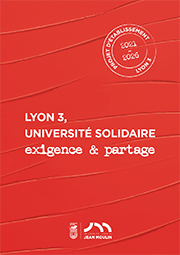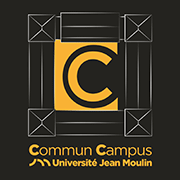AccueilRechercheProgrammes et productions scientifiquesThèsesThèses soutenuesThèses soutenues - 2006-2021Thèses soutenues - 2010
-
Partager cette page
- Recherche,
VERNISSE Caroline
L'illustration de l'oeuvre de Crebillon fils (XVIIIème-XXème siècle) : constitution d'une topique picturale
Publié le 19 janvier 2011 – Mis à jour le 19 janvier 2011
Thèse en Lettres - Langue et littérature fran?aise Soutenue le 10 décembre 2010
Le but de cette thèse, qui prend pour objet les illustrations des textes de Crébillon fils produites du XVIIIe au XXe siècle, est de montrer comment, à partir d’une ?uvre littéraire et d’une tradition iconographique (la peinture et l’illustration libertines du XVIIIe siècle), se constitue une ? topique picturale ? propre à l’illustration de cette ?uvre.
Au sein d’un corpus hétérogène de cinquante et une éditions illustrées, parues de 1735 à 1973, sont examinés, dans cette étude, les aspects matériels de l’art de l’illustration récurrents dans les éditions illustrées de l’?uvre de Crébillon, ainsi que la transposition en image des thématiques et de la poétique de ses textes. La mise en scène des libertins et du libertinage dépeints par l’auteur prend une large part dans les illustrations de notre corpus, dont les scènes libertines fondent la ? topique ?. Si de telles scènes s’inspirent de la tradition iconographique libertine du XVIIIe siècle, initiée par des peintres et illustrateurs d’autres ?uvres de cette époque, elles possèdent néanmoins des particularités qui en font des illustrations spécifiques à l’?uvre de Crébillon et qui les distinguent des autres représentations libertines du temps.
La transposition de la thé?tralité et de la réflexivité du texte, notamment, entre dans la définition de cette topique, qui possède donc des particularités ? poétiques ? ou, du moins, des équivalents picturaux à la poétique de l’auteur. L’illustration de l’?uvre de Crébillon se caractérise, en effet, par une forte dramatisation de l’action libertine, souvent thé?tralisée en image, et par des effets de mise à distance de la fiction, une ? inter-picturalité ? notamment, qui invitent à réfléchir sur l’illustration en tant qu’art et sur son contenu. Les allusions aux arts, à la peinture et au thé?tre en particulier, servent à construire la réflexivité de la vignette, tout en permettant aux illustrateurs de référer à leurs prédécesseurs, de perpétuer et de renforcer ainsi la ? topique picturale ? de l’illustration de cet auteur, qui perdure tout en s’actualisant au fil des siècles.
The purpose of this thesis, the object of which is the illustrations of the texts of Crébillon son produced from the XVIIIth century till the XXth century, is to show how, a “topique picturale” that is specific to this work, builds up on the basis of a literary work and on an iconographic tradition (the libertine painting and the illustration of the XVIIIth century).
Within a heterogeneous corpus of fifty one illustrated editions, published from 1735 to 1973, the material aspect of the art of illustration that are recurring in the illustrated editions of the work of Crébillon, are examined in this study, as well as the transposition in image of the themes and the poetics of his texts. The staging of libertines scenes and of libertinage depicted by the author represents a large part of the illustrations of our corpus, and largely founds its “topique”. If such scenes draw their inspiration from the libertine iconographic tradition of the XVIIIth century, as initiated by painters and illustrators of other works of that time, they nevertheless possess characteristics which make them illustrations that are specific to the work of Crébillon and which distinguish them from other libertines representations of that time.
The transposition of the theatricality and the reflexivity of the text, in particular, enters into the definition of this “topique”, which has therefore “poetic” characteristics or, at least, pictorial equivalents to the “poetic” of the author. The illustration Crébillon’s work is characterized, indeed, by a strong dramatization of the libertine behaviour , often supported by imagesand by putting fiction at a distance, an “inter-picturalité” in particular, which invites us to reflect on the illustration as an art and on its content. Allusions to arts, to painting and theatre in particular, are used to build the reflexivity of the label, while allowing illustrators to refer to their predecessors, to perpetuate and therefore reinforce the “topique picturale” of the illustration of this author, which perpetuates and is kept up to date over the centuries.
Mots clés : Crébillon fils, peinture, illustration, libertinage, XVIIIe siècle, topique picturale, transposition, thé?tralité, réflexivité, art.
Keywords : Crébillon son, painting, illustration, libertinage, XVIIIth century, topique picturale, transposition, theatricality, reflexivity, art.
Directeur de thèse : Régine Jomand-Baudry
Membres du jury :
Michel DELON, Professeur, Université Paris Sosrbonne
Philip STEWART, Professeur émérite, Université Duke (USA)
Christophe MARTIN, Professeur, Université Paris 10 Nanterre
Régine JOMAND-BAUDRY, Professeur, Université Jean Moulin Lyon 3
Mention : Très honorable avec les félicitations du jury
Equipe d'accueil : Centre Jean Prévost
Au sein d’un corpus hétérogène de cinquante et une éditions illustrées, parues de 1735 à 1973, sont examinés, dans cette étude, les aspects matériels de l’art de l’illustration récurrents dans les éditions illustrées de l’?uvre de Crébillon, ainsi que la transposition en image des thématiques et de la poétique de ses textes. La mise en scène des libertins et du libertinage dépeints par l’auteur prend une large part dans les illustrations de notre corpus, dont les scènes libertines fondent la ? topique ?. Si de telles scènes s’inspirent de la tradition iconographique libertine du XVIIIe siècle, initiée par des peintres et illustrateurs d’autres ?uvres de cette époque, elles possèdent néanmoins des particularités qui en font des illustrations spécifiques à l’?uvre de Crébillon et qui les distinguent des autres représentations libertines du temps.
La transposition de la thé?tralité et de la réflexivité du texte, notamment, entre dans la définition de cette topique, qui possède donc des particularités ? poétiques ? ou, du moins, des équivalents picturaux à la poétique de l’auteur. L’illustration de l’?uvre de Crébillon se caractérise, en effet, par une forte dramatisation de l’action libertine, souvent thé?tralisée en image, et par des effets de mise à distance de la fiction, une ? inter-picturalité ? notamment, qui invitent à réfléchir sur l’illustration en tant qu’art et sur son contenu. Les allusions aux arts, à la peinture et au thé?tre en particulier, servent à construire la réflexivité de la vignette, tout en permettant aux illustrateurs de référer à leurs prédécesseurs, de perpétuer et de renforcer ainsi la ? topique picturale ? de l’illustration de cet auteur, qui perdure tout en s’actualisant au fil des siècles.
The purpose of this thesis, the object of which is the illustrations of the texts of Crébillon son produced from the XVIIIth century till the XXth century, is to show how, a “topique picturale” that is specific to this work, builds up on the basis of a literary work and on an iconographic tradition (the libertine painting and the illustration of the XVIIIth century).
Within a heterogeneous corpus of fifty one illustrated editions, published from 1735 to 1973, the material aspect of the art of illustration that are recurring in the illustrated editions of the work of Crébillon, are examined in this study, as well as the transposition in image of the themes and the poetics of his texts. The staging of libertines scenes and of libertinage depicted by the author represents a large part of the illustrations of our corpus, and largely founds its “topique”. If such scenes draw their inspiration from the libertine iconographic tradition of the XVIIIth century, as initiated by painters and illustrators of other works of that time, they nevertheless possess characteristics which make them illustrations that are specific to the work of Crébillon and which distinguish them from other libertines representations of that time.
The transposition of the theatricality and the reflexivity of the text, in particular, enters into the definition of this “topique”, which has therefore “poetic” characteristics or, at least, pictorial equivalents to the “poetic” of the author. The illustration Crébillon’s work is characterized, indeed, by a strong dramatization of the libertine behaviour , often supported by imagesand by putting fiction at a distance, an “inter-picturalité” in particular, which invites us to reflect on the illustration as an art and on its content. Allusions to arts, to painting and theatre in particular, are used to build the reflexivity of the label, while allowing illustrators to refer to their predecessors, to perpetuate and therefore reinforce the “topique picturale” of the illustration of this author, which perpetuates and is kept up to date over the centuries.
Mots clés : Crébillon fils, peinture, illustration, libertinage, XVIIIe siècle, topique picturale, transposition, thé?tralité, réflexivité, art.
Keywords : Crébillon son, painting, illustration, libertinage, XVIIIth century, topique picturale, transposition, theatricality, reflexivity, art.
Directeur de thèse : Régine Jomand-Baudry
Membres du jury :
Michel DELON, Professeur, Université Paris Sosrbonne
Philip STEWART, Professeur émérite, Université Duke (USA)
Christophe MARTIN, Professeur, Université Paris 10 Nanterre
Régine JOMAND-BAUDRY, Professeur, Université Jean Moulin Lyon 3
Mention : Très honorable avec les félicitations du jury
Equipe d'accueil : Centre Jean Prévost
Documentation
Mise à jour : 19 janvier 2011







